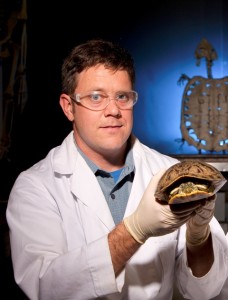James Dearworth, associate professor of biology, has a long history with turtles. He studied the functional anatomy of the turtle retina as a grad student, and it is the focus of his current research at Lafayette. Turtles, having been around in shell form since the time of dinosaurs, have an even longer history and offer an interesting perspective for a better understanding of the human eye and brain.

Professor James Dearworth
With the help of nine students, Dearworth has collaborated with Saint Louis University researchers Michael Ariel and Michael Jones on a study that has been published in the October edition of The Journal of Comparative Neurology. The team reported surprising findings about the eye movements of pond turtles that can retract their heads deep into their shells.
Dearworth often includes students in his work as research assistants through the College’s EXCEL Scholars Undergraduate Research program and independent study and honors theses programs. This project has spanned several years and all nine of the students, who have since graduated, are named as coauthors on the study.
Joel Kaye ’11, a neuroscience graduate, collected and analyzed data from the trochlear, abducens, and oculomotor nerves of the turtle’s eye. His work with Dearworth was a vital part of his undergraduate experience as he is now in his second year of medical school at Robert Wood Johnson University Hospital in New Brunswick, N.J.
“Not only did I learn the ins-and-outs of how to conduct bench research, I also learned the valuable skills of data analysis and how to properly write a scientific paper,” says Kaye. “The skills I learned while doing research at Lafayette have translated over to the clinical research that I’m currently conducting in the neurosurgery department at Robert Wood Johnson.”
The research found that the pond turtle can exhibit eye movement similar to that of mammals. Humans, and other mammals like cats and monkeys, have their eyes viewing forward. In contrast, most lower vertebrates, including turtles, have eyes that are lateral — on the side of their heads. Of the six muscles that move each eye, the muscles that move lateral eyes differ from the muscles of animals that move eyes viewing forward.
While the researchers expected that the pond turtle’s eyes would operate like other animals with eyes on the side of their heads, this particular species of turtle appears to have characteristics of both front and side-eyed animals, affecting a specific eye muscle’s direction of pull and the turtle’s eye position when its peripheral vision is blocked by its shell.
In an earlier study, Ariel and Jones made an unexpected observation when studying the vestibulo-ocular reflex (VOR), which allows the eyes to adjust their position when the head is moving. They found that a nerve that moves one of the pond turtle’s eye muscles, the superior oblique muscle, was active when that turtle moved its head from side to side, much like that of animals whose eyes view forward.
In the current study, Dearworth’s team found that a turtle pulls its eyes in different directions when its head is out of its shell compared to when its head is retracted deep within its shell. Because the pond turtle can pull its head entirely into its shell, resulting in an obstructed field of vision, it appears that this turtle has developed a way to compensate and direct its eyes forward to best examine its environment. Moreover, the superior oblique muscle may play a role in this behavior as its direction of pull is more like that of a front-eyed animal than that of animals with eyes on the side of their heads.
Dearworth’s research assistants have moved on to careers and graduate schools in various fields. They are:
- Alyssa Ashworth ’11 (biology) is attending St. John Fisher College School of Pharmacy
- Dustin Bednarz ’08 (biology) is staff attorney for a trade association in Washington
- Justin Blaum ’08 (biology) received a D.O. and is an emergency medicine resident at Mercy St. Vincent Medical Center
- Kelly Higgins ’10 (biology) is a physician’s assistant after graduating from Philadelphia College of Osteopathic Medicine
- Julie McNeish ’09 (biology) received a D.M.D. and is pursuing a specialty in oral and maxillofacial surgery
- Chelsea Michael ’09 (neuroscience) is a coordinator for a cancer epidemiology/genetic epidemiology study at Johns Hopkins
- Michael Skrobola ’12 (biology) is a dental student
- Jason Vacca ’08 (biology) is a surgical device sales representative for Proficient Surgical
Content from this story was borrowed from a Saint Louis University’s press release dated Sept. 18, 2013.
